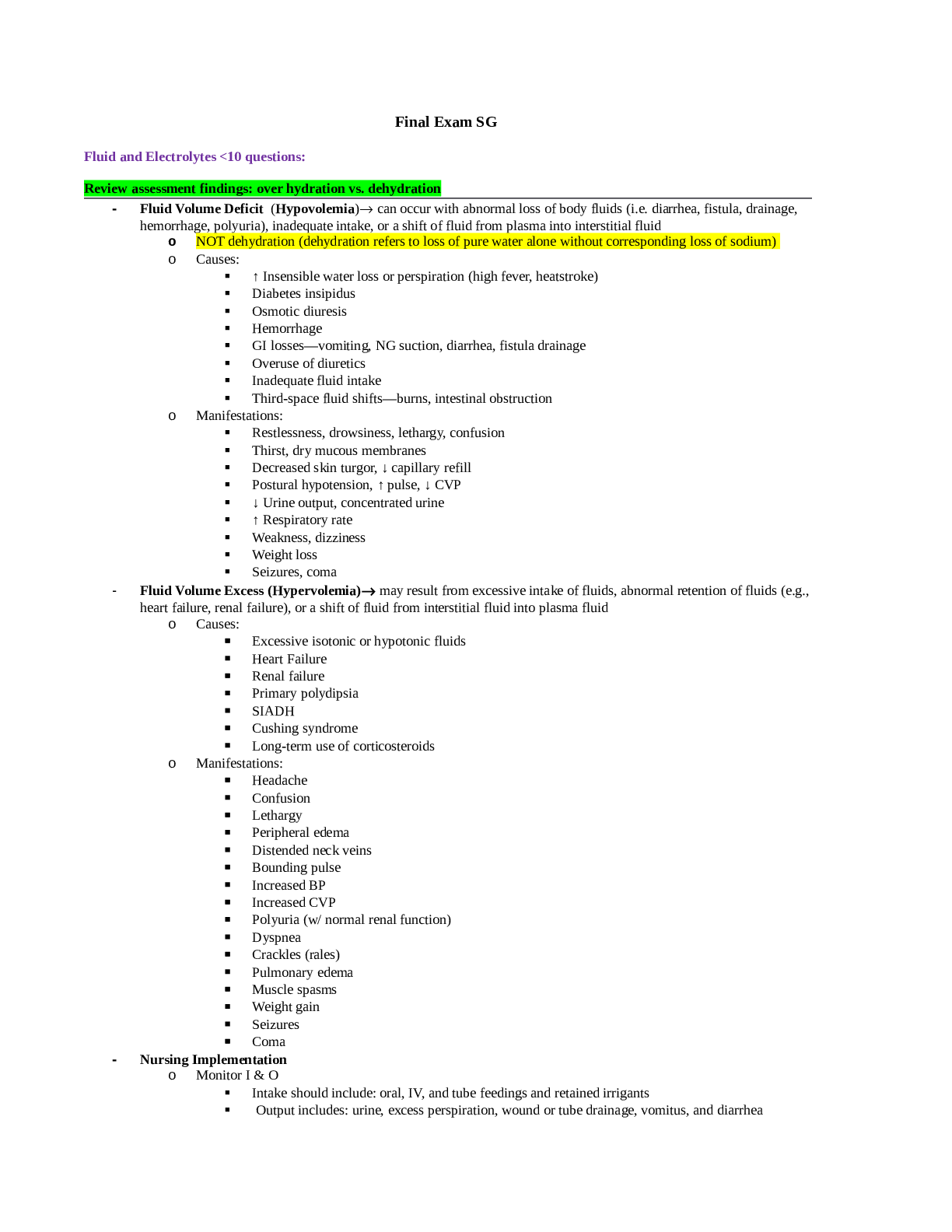- Fluid Volume Deficit (Hypovolemia) can occur with abnormal loss of body fluids (i.e. diarrhea, fistula, drainage,
hemorrhage, polyuria), inadequate intake, or a shift of fluid from plasma into interstitial fluid
o NOT dehydration (dehydration refers to loss of pure water alone without corresponding loss of sodium)
o Causes:
↑ Insensible water loss or perspiration (high fever, heatstroke)
Diabetes insipidus
Osmotic diuresis
Hemorrhage
GI losses—vomiting, NG suction, diarrhea, fistula drainage
Overuse of diuretics
Inadequate fluid intake
Third-space fluid shifts—burns, intestinal obstruction
o Manifestations:
Restlessness, drowsiness, lethargy, confusion
Thirst, dry mucous membranes
Decreased skin turgor, ↓ capillary refill
Postural hypotension, ↑ pulse, ↓ CVP
↓ Urine output, concentrated urine
↑ Respiratory rate
Weakness, dizziness
Weight loss
Seizures, coma
- Fluid Volume Excess (Hypervolemia) may result from excessive intake of fluids, abnormal retention of fluids (e.g.,
heart failure, renal failure), or a shift of fluid from interstitial fluid into plasma fluid
o Causes:
Excessive isotonic or hypotonic fluids
Heart Failure
Renal failure
Primary polydipsia
SIADH
Cushing syndrome
Long-term use of corticosteroids
o Manifestations:
Headache
Confusion
Lethargy
Peripheral edema
Distended neck veins
Bounding pulse
Increased BP
Increased CVP
Polyuria (w/ normal renal function)
Dyspnea
Crackles (rales)
Pulmonary edema
Muscle spasms
Weight gain
Seizures
Coma
- Nursing Implementation
o Monitor I & O
Intake should include: oral, IV, and tube feedings and retained irrigants
Output includes: urine, excess perspiration, wound or tube drainage, vomitus, and diarrhea
Estimate fluid loss from wounds and perspiration
Measure the urine specific gravity, >1.025 = concentrated and <1.010 = dilute urine
FVE S/S = pulse is full and bounding, pulse is not easily obliterated, distended neck veins (jugular
venous distention), increased blood pressure
FVD S/S = mild to moderate fluid volume deficit: compensatory mechanisms include sympathetic
nervous system stimulation of the heart and peripheral vasoconstriction
Stimulation of the heart increases the heart rate and, combined with vasoconstriction,
maintains the blood pressure within normal limits; change in position from lying to
sitting or standing = increase in the heart rate or a decrease in the blood pressure
(orthostatic hypotension); if vasoconstriction and tachycardia provide inadequate
compensation, hypotension occurs when the patient is recumbent
Severe fluid volume deficit: weak, thready pulse that is easily obliterate, flattened neck
veins
Severe, untreated fluid deficit = shock
o Respiratory Changes
ECF excess = pulmonary congestion and pulmonary edema as increased hydrostatic pressure in the
pulmonary vessels forces fluid into the alveoli
S/S: shortness of breath, irritative cough, and moist crackles on auscultation
ECF deficit = an increased respiratory rate due to decreased tissue perfusion and resultant hypoxia
o Neurological Changes
ECF excess = cerebral edema as a result of increased hydrostatic pressure in cerebral vessels
ECF deficit = alteration in sensorium secondary to reduced cerebral tissue perfusion
Assessment of neurologic function includes evaluation of
o (1) the level of consciousness, which includes responses to verbal and painful
stimuli and the determination of a person's orientation to time, place, and
person
o (2) pupillary response to light and equality of pupil size
o (3) voluntary movement of the extremities, degree of muscle strength, and
reflexes
o Daily Weights
Increase of 1 kg (2.2 lb) is equal to 1000 mL (1 L) of fluid retention (provided the person has
maintained usual dietary intake or has not been on nothing-by-mouth [NPO] status)
Pt. weighed at the same time every day, wearing the same garments, and on the same
carefully calibrated scale
o Remove excess bedding and empty all drainage bags
o If bulky dressings or tubes are present, which may not necessarily be used
every day, record a notation regarding these variables on the flowsheet or
nursing notes
o Skin Assessment
Skin areas over the sternum, abdomen, and anterior forearm- pinch for turgor (less predictive of
fluid deficit in older persons because of the loss of tissue elasticity)
ECF volume deficit
Skin turgor is diminished; there is a lag in the pinched skinfold's return to its original
state (tenting) Cause the skin to appear dry and wrinkled (older adult= normally dry, wrinkly, and
unelastic)
Oral mucous membranes will be dry, the tongue may be furrowed, and complaints of
thirst
Skin may be cool and moist if there is vasoconstriction to compensate for the decreased
fluid volume
Mild hypovolemia usually does not stimulate this compensatory response
The skin will be warm and dry
ECF volume excess
Skin that is edematous may feel cool because of fluid accumulation and a decrease in
blood flow secondary to the pressure of the fluid
Fluid can also stretch the skin, causing it to feel taut and hard; assess for edema over tibia
or fibia
o Protect edematous tissues from extremes of heat and cold, prolonged pressure,
and trauma
o Frequent skin care and changes in position will protect the patient from skin
breakdown
o Elevation of edematous extremities helps promote venous return and fluid
reabsorption
o Dehydrated skin needs frequent care without the use of soap
Read More


